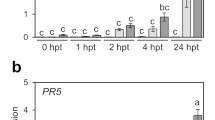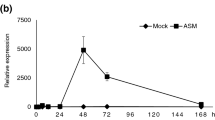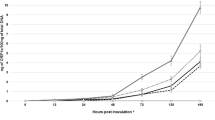Abstract
The effect of a novel synthetic signal molecule, acibenzolar-S-methyl (CGA-245704; benzo [1,2,3] thiadiazole-7-carbothioic acid S-methyl ester), in inducing resistance in sugarcane against red rot disease caused by the fungusColletotrichum falcatum Went was studied. Application of CGA-245704 as a soil drench or along with marcotting rooting mixture induced resistance in sugarcane to challenge inoculation withC. falcatum. When the pathogen was inoculated by the plug method, it caused discoloration in the untreated control stalk tissues; however, in the stalk tissues pretreated with acibenzolar-S-methyl, pathogen colonization was considerably reduced. When the pathogen was inoculated by nodal swabbing, its penetration was arrested in the sensitized stalk tissues. An induced systemic resistance effect was found to persist up to 30 days in the pretreated cut canes. Increased phenolic content and accumulation of pathogenesis-related (PR) proteins,viz., chitinase, β-1,3-glucanase and thaumatin-like protein (PR-5), were observed in sugarcane plants treated with acibenzolar-S-methyl.
Similar content being viewed by others
References
Benhamou, N. and Belanger, R.R. (1998) Induction of systemic resistance toPythium damping-off in cucumber plants by benzothiadiazole — infrastructure and cytochemistry of the host response.Plant J. 14:13- 21.
Berger, L.R. and Reynolds, D.M. (1958) The chitinase system of a strain ofStreptomyces griseus. Biochem.Biophys. Acta 29:522–534.
Bol, J.F., Linthorst, H.J.M. and Cornelessen, B.J.C. (1990) Plant pathogenesis related proteins induced by virus infection.Annu. Rev. Phytopathol. 28:113–138.
Boiler, T. and Mauch, F. (1988) Colorimetric assay for chitinase.Methods Enzymol, 161:430–435.
Broglie, K., Chet, I., Holliday, M., Cressman, R., Biddle, P., Knowlton, S.et al, (1991) Transgenic plants with enhanced resistance to the fungal pathogenRhizoctonia solani.Science 254:1194–1197.
Carrasco, A., Boudet, A.M. and Marigo, G. (1978) Enhanced resistance of tomato plants toFusarium by controlled stimulation of their natural phenolic production.Physiol. Plant Pathol, 12:225–232.
Chen, W.P., Chen, P.D., Liu, D.J., Kynast, R., Friebe, B., Velazhahan, R.et al, (1999) Development of wheat scab symptoms is delayed in transgenic wheat plants that constitutively express a rice thaumatin-like protein gene.Them. Appl. Genet. 99:755–760.
Chona, B.L. (1980) Red rot of sugarcane and sugar industry—a review.Indian Phytopathol, 33:191–207.
Cohen, Y., Gisi, U. and Niderman, T. (1993) Local and systemic protection againstPhytophthora infestans induced in potato and tomato plants by jasmonic acid methyl ester.Phytopathology 83:1054–1062.
Cohen, Y, Reuveni, M. and Baider, A. (1999) Local and systemic activity of BABA (DL-3-aminobutyric acid) againstPlasmopara viticola in grapevines.Eur. J. Plant Pathol. 105:351–361.
Datta, K., Tu, J., Oliva, N., Ona, I., Velazhahan, R., Mew, T.W.et al. (2001) Enhanced resistance to sheath blight by constitutive expression of infection-related rice chitinase in transgenic elite indica rice cultivars.Plant Sci. 160:405–414.
Datta, K., Velazhahan, R., Oliva, N., Ona, I., Mew, T, Khush, G.S.et al. (1999) Over expression of cloned rice thaumatin-like protein (PR5) gene in transgenic rice plants enhances environmental friendly resistance toRhizoctonia solani causing sheath blight disease.Theor. Appl, Genet. 98:1138–1145.
Dean, R.A. and Kuć, J. (1986) Induced systemic protection in cucumber: time of production and movement of the signal.Phytopathology 76:966–970.
Dean, R.A. and Kuć, J. (1986) Induced systemic protection in cucumber: the source of the signal.Physiol, Mol. Plant Pathol. 28:227–233.
Dean, R.A. and Kuć, J. (1987) Rapid lignification in response to wounding and infection as a mechanism for induced systemic protection in cucumber.Physiol. Mol, Plant Pathol, 31:69–81.
Delany, T.P., Friedrich, L., Kessmann, H., Uknes, S., Vernooij, B., Ward, E.et al, (1994) The molecular biology of systemic acquired resistance:in: Daniels, M. [Ed.] Advances in Molecular Genetics of Plant- Microbe Interactions. Vol. 3, pp. 339–347. Kluwer Academic Press, Dordrecht, the Netherlands.
Dixon, R.A. and Lamb, C.J. (1990) Molecular communication in interactions between plants and microbial pathogens.Annu. Rev. Plant Physiol. Plant Mol. Biol. 41:339–367.
Enkerli, J., Gisi, U. and Mosinger, E. (1993) Systemic acquired resistance toPhytophthora infestans in tomato and the role of pathogenesis related proteins.Physiol. Mol. Plant Pathol, 43:161–171.
Enyedi, A.J., Yalpani, N., Silverman, P. and Raskin, I. (1992) Localization conjugation and function of salicylic acid in tobacco during the hypersensitive reaction to tobacco mosaic virus.Proc. Natl. Acad. Sci. USA 89:2480–2484.
Friedrich, L., Lawton, K., Ruess, W., Masner, P., Specker, N., Rella, M.G.et al. (1996) A benzothiadiazole derivative induces systemic acquired resistance in tobacco.Plant J. 10:61–70.
Gianinnazi, S. (1984) Genetic and molecular aspects of resistance induced by molecules or chemicals.in: Kosuge, T. and Nester, E.W. [Eds.] Plant-Microbe Interactions, Vol. I. Molecular and Genetic Perspectives, pp. 321 -342. Macmillan, New York, NY.
Gorlach, J., Volrath, S., Knauf-Beiter, G., Hengy, G., Beckhove, U., Kogel, K.H.et al. (1996) Benzothia- diazole—a novel class of inducers of systemic acquired resistance activates gene expression and disease resistance in wheat.Plant Cell 8:629–643.
Hammerschmidt, R. (1999) Induced disease resistance: How do induced plants stop pathogens?Physiol. Mol. Plant Pathol. 55:77–84.
Hoffland, E., Pieterse, C.M.J., Bik, L. and Van Pett, J.A. (1995) Induced systemic resistance in radish is not associated with accumulation of pathogenesis-related proteins.Physiol. Mol. Plant Pathol. 46:309–320.
Hong, J.K., Hwang, B.K. and Kim, C.H. (1999) Induction of local and systemic resistance toColletotrichum coccodes in pepper plants by DL-β-amino-n-butyric acid.J. Phytopathol. 147:193–198.
Ishii, H., Tomita, Y, Horio, T., Narusaka, Y, Nakazawa, Y, Nishimura, K.et al. (1999) Induced resistance of acibenzolar-S-methyl (CGA-245704) to cucumber and Japanese pear diseases.Eur. J. Plant Pathol. 105:77- 85.
Jensen, B.D., Latundedada, A.O., Hudson, D. and Lucas, J.A. (1998) Protection ofBrassica seedlings against downy mildew and damping-off by seed treatment with CGA-245704, an activator of systemic acquired resistance.Pestic. Sci. 52:63–69.
Kaji, M., Hirata, A., Nikajima, Y, Sugii, S. and Tsujimoto, K. (1997) Control mechanism of new plant activator, CGA-245704 against rice blast.Ann. Phytopathol. Soc. Jpn. 63:222–223.
Kauffmann, S., Legrand, M., Jeoffroy, P. and Fritig, B. (1987) Biological function of pathogenesis-related proteins. Four PR-proteins of tobacco have l,3-β-glucanase activity.EMBO J. 6:3209–3212.
Kessmann, H., Staub, T, Hofmann, C, Maetzke, T., Herzog, J., Ward, E.et al. (1994) Induction of systemic acquired resistance in plants by chemicals.Annu. Rev. Plant Pathol. 32:439–459.
Kombrink, E. and Somssich, I.E. (1997) Pathogenesis related proteins and plant defence.in: Carroll, G. and Tudzynski, P. [Eds] The Mycota. V, Part A. Plant Relationships. Springer Verlag, Berlin, Germany. pp. 107–128.
Kunz, W., Schurter, R. and Maetzke, T. (1997) The chemistry of BTH plant activators.Pestic. Sci. 50:275- 282.
Laemmli, U.K. (1970) Cleavage of structural proteins during the assembly of the head of bacteriophage T4.Nature (Lond.) 227:680–685.
Lamb, C.J., Lawton, M.A., Dron, M. and Dixon, R.A. (1989) Signals and transduction mechanisms for activation of plant defenses against microbial attack.Cell 56:215–224.
Lawton, K.A., Friedrich, L., Hunt, M., Weymann, K., Delaney, T, Kessmann, H.et al. (1996) Benzothiadi- azole induces resistance inArabidopsis by activation of the systemic acquired resistance signal transduction pathway.Plant J. 10:71–82.
Legrand, M., Kauffmann, S., Jeoffroy, P. and Fritig, B. (1987) Biological function of pathogenesis-related proteins; Four tobacco pathogenesis-related proteins are chitinases.Proc. Natl. Acad. Sci. USA 84:6750–6754.
Lin, W., Anuratha, C.S., Datta, K., Potrykus, I., Muthukrishnan, S. and Datta, S.K.(1995) Genetic engineering of rice for resistance to sheath blight.Bio/Technology 13:686–691.
Lyon, G.D. and McGill, F.M. (1988) Inhibition of growth ofErwinia carotovora in vitro by phenolics.Potato Res. 31:461–467.
Mauch, F., Mauch-Mani, B. and Boiler, T. (1998) Antifungal hydrolases in pea tissue. II. Inhibition of fungal growth by combinations of chitinase and β-1,3-glucanase.Plant Physiol. 88:936–942.
Metraux, J.P., Ahl-Goy, P., Staub, T, Speich, T., Steinamann, R., Ryals, J.et al. (1991) Induced resistance in cucumber in response to 2,6-dichloroisonicotinic acid and pathogens.in: Verma, PS. [Ed.] Advances in Molecular Genetics of Plant-Microbe Interactions. Kluwer Academic Publishers, Dordrecht, the Netherlands.Vol. 1, pp. 432–439.
Mohanraj, D., Padmanaban, P., Viswanathan, R. and Alexander, K.C. (1997) Sugarcane screening for red rot resistance.Sugarcane 3:18–23.
Morris, S.W., Vernory, B., Titatarn, S., Starrett, M., Thomas, S., Wiltse, C.C.et al. (1998) Induced resistance responses in maize.Mol. Plant-Microbe Interact. 11:643–658.
Narusaka, Y, Narusaka, M., Horio, T. and Ishii, H. (1999) Comparison of local and systemic induction of acquired disease resistance in cucumber plants treated with benzothiadiazole or salicylic acid.Plant Cell Physiol. 40:388–395.
Oostendorp, M. von, Kessman, H., Friedrich, L., Geissmann, A., Gorlach, J., Hengy, G.et al. (1996) Influence of plant activator Bion and of triazole fungicides on plant defense mechanism.Gesunde Pflanze 48:260–264.
Pan, S.Q., Ye, X.S. and Kuc, J. (1991) A technique for detection of chitrnases, β-1,3-glucanase, and protein patterns after a single separation using polyacylamide gel electrophoresis or isoelectricfocusing.Phytopathology 81:970–974.
Pieterse, C.M.J., Van Wees, S.C.M., Van Pelt, J.A., Knoester, M, Laan, R., Gerrits, H.et al. (1998) A novel signalling pathway controlling induced systemic resistance inArabidopsis.Plant Cell 10:1571–1580.
Raum, J. (1997) “Bion”—A plant activator also forvegetable gardening.Gemuse (Munchen) 33 (3):185–187.
Reissig, J.L., Strominger, J.L. and Leloir, L.F. (1955) A modified colorimetric method for the estimation of N-acetylamino sugars.J. Biol. Chem. 217:959–966.
Ruess, W., Kunz, W., Staub, T., MGller, K., Poppinger, N., SpeichJ., et al, (1995) Plant activator CGA- 245704, a new technology for disease management.Abstr. XIII Int. Plant Protection Congr. (the Hague, the Netherlands).
Ruess, W., Mueller, K., Knauf-Beiter, G., Kauf, W. and Staub, T. (1996) Plant activator CGA-245704 - an innovative approach for disease control in cereals and tobacco.Proc. Brighton Crop Protection Conf. Pests and Diseases (Brighton, UK), Vol. 1, pp. 53–60.
Ryals, J., Lawton, K.A., Delaney, T.P., Friedrich, L., Kessmann, H., Neuenschwander V.,etal, (1995) Signal transduction in systemic acquired resistance.Proc. Natl. Acad. Sci. USA 92:4202–4205.
Ryals, J.A., Neuenschwander, U.H., Willits, M.G., Molina, A., Steiner, H.Y. and Hunt, M.D. (1996) Systemic acquired resistance.Plant Cell 8:1809–1819.
Schlosser. E. (1997) SAR—a new dimension in plant protection.Arab.J Plant Prot. 15:149–150.
Schlumbaum, A., Mauch, R, Vogeli, V. and Boiler, T. (1986) Plant chitinases are potent inhibitors of fungal growth.Nature (Lond.) 324:365–367.
Schweizer, P., Schlagenhauf, E., Schaffrath, E., Schaffrath, U. and Dudler, R. (1999) Different patterns of host genes are induced in rice byPseudomonas syringae, a biological inducer of resistance and the chemical inducer benzodiathiazole (BTH).Eur. J. Plant Pathol. 105:659–665.
Shulaev, V, Leon, J. and Raskin, I. (1996) Is salicylic acid a translocated signal of systemic acquired resistance in tobacco?Plant Cell 7:1691–1701.
Siegrist, J., Winkal, D.G., Kolle, C. and Schmidtke, M. (1997) Chemically induced resistance in green bean against bacterial and fungal pathogens.J. Plant Dis. Prot. 104:599–610.
Singh, K. and Singh, R.P. (1989) Red rot.in: Ricaud, C.G., Egan, B.T., Gillaspie, A.G. and Hughes, C.G. [Eds.] Sugarcane Diseases of the World: Major Diseases. Elsevier, Amsterdam, the Netherlands. pp. 169–188.
Srinivasan, K.V. and Bhat, N. (1961) Red rot of sugarcane—criteria for grading resistance.J. Indian Bot. Soc. 40:566–577.
Sundara, B. (1998) Sugarcane Cultivation. Vikas Publishing House, New Delhi, India.
Toal, E.S., and Jones, P.W. (1999) Induction of systemic resistance toSclerotinia sclerotiorum by oxalic acid in oilseed rape.Plant Pathol. 48:759–767.
Uknes, S., Mauch-Mani, B., Moyer, M., Potter, S., Williams, S., Dincher, S.et al. (1992) Acquired resistance in arabidopsis.Plant Cell 4:645–656.
Van Loon, L.C., Bakker, P.A.H.M. and Pieterse, C.M.J. (1998) Systemic resistance induced by rhizosphere bacteria.Annu. Rev. Phytopathol. 36:453–483.
Velazhahan, R., Datta, S.K. and Muthukrishnan, S. (1999) The PR-5 family; Thaumatin-like proteins,in: Datta, S.K. and Muthukrishnan, S. [Eds.] CRC Press, Boca Raton, FL, USA. pp. 107–129.
Velazhahan, R., Samiyappan, R. and Vidhyasekaran, P. (2000) Purification of an elicitor-inducible antifungal chitinase from suspension-cultured rice cells.Phytoparasitica 28:131–139.
Vidhyasekaran, P. (1998) Fungal Pathogenesis in Plants and Crops. Marcel Dekker Inc., New York, NY.
Vigers, A.J., Roberts, W.K. and Selitrennikoff, C.P. (1991) A new family of plant antifungal proteins.Mol. Plant-Microbe Interact. 4:315–323.
Viswanathan, R., Mohanraj, D. and Padmanabhan, P. (1998) Comparison of three testing methods for evaluation of resistance to red rot caused byColletotrichum falcatum in sugarcane (Saccharum ojficinarum).Indian J. Agric. Sci. 68:226–230.
Viswanathan, R. and Samiyappan, R. (1999) Red rot disease of sugarcane: Major constraint for Indian sugar industry.Sugarcane 5:9–15.
White, R.F. (1979) Acetylsalicylic acid (aspirin) induces resistance to tobacco mosaic virus in tobacco.Virology 99:410–412.
Zhu, B., Chen, T.H.H. and Li, R.H. (1996) Analysis of late blight disease resistance and freezing tolerance in transgenic potato plants expressing sense and antisense genes for an osmotin-like protein.Planta 198:70–77.
Zieslin, N. and Ben-Zaken, R. (1993) Peroxidase activity and presence of phenolic substances in peduncles of rose flowers.Plant Physiol. Biochem. 31:333–339.
Author information
Authors and Affiliations
Corresponding author
Rights and permissions
About this article
Cite this article
Sundar, A.R., Velazhahan, R., Viswanathan, R. et al. Induction of systemic resistance toColletotrichum falcatum in sugarcane by a synthetic signal molecule, acibenzolar-S-Methyl(CGA-245704). Phytoparasitica 29, 231–242 (2001). https://doi.org/10.1007/BF02983455
Received:
Revised:
Issue Date:
DOI: https://doi.org/10.1007/BF02983455




